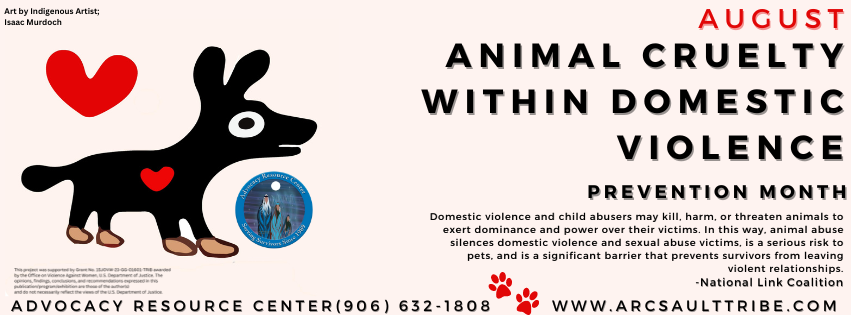August: The Link Between AnimaL Abuse and Domestic Violence

The Link Between Animal Abuse and Domestic Violence For many of us, our pets are like our children. We cherish them, we love them, and we protect them with our lives. For those in a domestic violence relationship, often their pets suffer abuse, too. Many victims of domestic violence choose to remain in the abusive relationship out of fear of further abuse their beloved pet may suffer if they had to leave them behind. Victims have reported that their abuser has threatened or physically abused their pet as a form of control, often causing emotional violence towards their partner.
What exactly is animal cruelty? Animal cruelty deprives animals of food, water, shelter, or veterinary care. Animal cruelty also includes physically inflicting pain, torturing, maiming, or killing animals. Animal cruelty is a felony crime in all 50 states. Some states allow pets to be included in personal protection orders to protect animals and victims better. Michigan is one of them. A national database was created in 2016 that tracks crimes against animals, called the National Incident-Based Reporting System (NIBRS).
However, we as a society need to be more consistent about reporting animal abuse and ensuring that law enforcement follows up with investigating, prosecuting, and punishing abusers to the fullest extent of the law.
Research has found a direct “link” between cruelty to animals and violence towards humans. It is inevitably called “The Link.” It is proven that “The Link” connects acts of cruelty toward animals to acts of violence toward humans. Research has shown that those abusing animals are most likely to harm children, intimate partners, and elders and enact violent behaviors. This link is why law enforcement must take cruelty towards animals seriously. For information on “The Link,” you can visit The National Link Coalition (www.nationallinkcoalition.org) is the only international educational and advocacy organization working to prevent animal cruelty, domestic violence, child maltreatment, and elder abuse by showing how they intersect.
To report any animal abuse in Michigan, use this link to find the animal control office near you. (https://nationallinkcoalition.org/how-do-i-report-suspected-abuse/michigan) Animals need to be protected, someone to advocate for them, and law enforcement and the judicial system to punish abusers who are cruel to helpless animals.
Abused and neglected children are also at risk of inflicting violence on animals. Children who witness animal abuse are at risk of becoming abusers themselves. Children who harm animals need immediate help and should be referred to a specialist who can assess their emotional health and their mental well-being.
Some key points to understand the connection between domestic abuse and animal abuse:
1. Power and Control: Perpetrators of domestic violence may harm animals by controlling and intimidating their victims. Hurting or threatening to harm pets can be used as a way to instill fear and ensure compliance from the victim.
2. Indicator of Domestic Abuse: The presence of animal abuse in a household can indicate the severity of domestic abuse. If animals in the home are being mistreated, there is a higher likelihood that the human family members are also experiencing abuse.
3. Emotional Manipulation: Abusers may use pets to manipulate their victims emotionally. They might threaten to harm or kill the animals if the victim tries to leave or seek help, trapping them in an abusive relationship.
4. Emotional Bond: Many victims of domestic violence form strong emotional bonds with their pets, often considering them part of their family. Abusers may exploit this attachment to exert control and inflict emotional pain on the victim.
5. Isolation: Abusers may isolate their victims by limiting their access to resources and support networks, including their pets. This can make it harder for the victim to seek help or leave the abusive situation.
6. Learned Behavior: In some cases, individuals who witnessed animal abuse during childhood may be more likely to perpetrate domestic violence as adults. The normalization of violence in their upbringing can influence their behavior later in life.
7. Protective Factors: Recognizing the link between domestic and animal abuse can help organizations and support systems create better interventions and protective measures for human and animal victims.
What can you do to help? Report animal abuse. If you know or suspect someone is abusing an animal, report it to your local law enforcement agency and the nearest animal control office. Be sure to share details of the abuse the animal is suffering. Report the names, addresses, locations, cross streets, phone numbers, descriptions of property, and other pertinent information that may help save the animal. Also, let your lawmakers know that you wish to see more animal protection laws enacted and more vital punishments for abusers. Overall, understanding the link between domestic abuse and animal abuse is essential in creating a comprehensive support system and addressing the needs of all victims involved in such situations.
The Advocacy Resource Center’s “Lodge of Bravery” is a haven for victims of domestic violence. It also has an on-site, climate-controlled kennel for pets to reside safely while staying with their beloved owner at the shelter. If you seek advocacy, please contact the Advocacy Resource Center at (906) 632-1808. You are not alone. We can help.
References: (https://humaneactionpittsburgh.org/the-link-between-animal-abuse-and-domestic-violence/) https://aldf.org/article/the-link-between-cruelty-to-animals-and-violence-toward-humans-2/